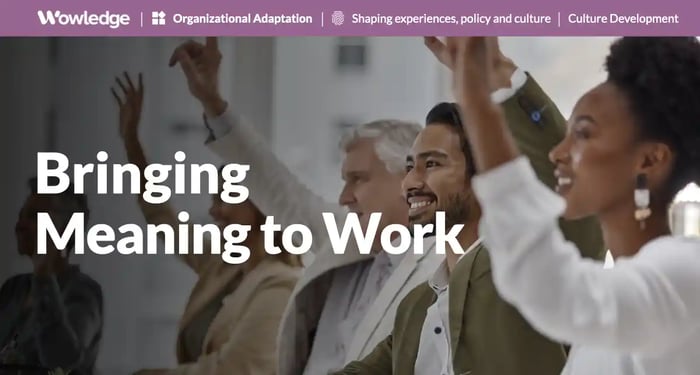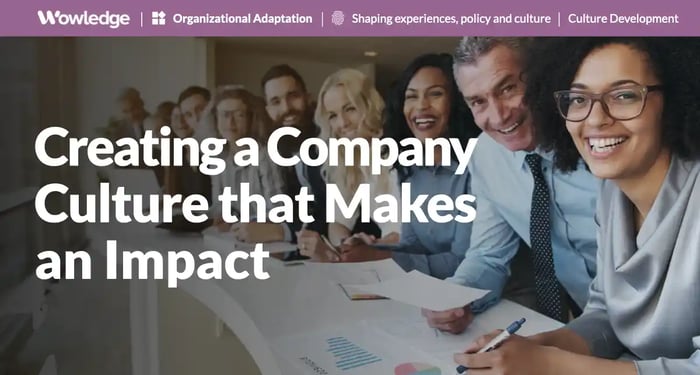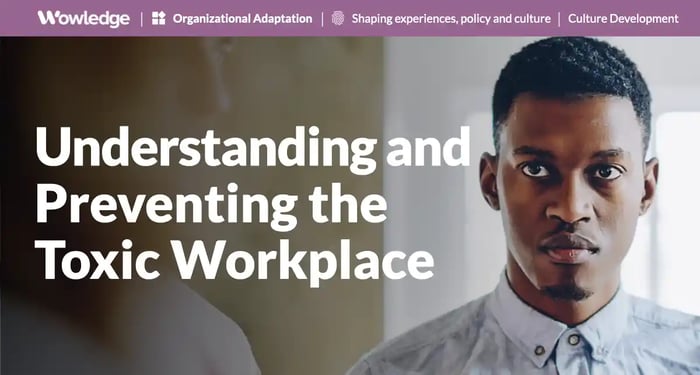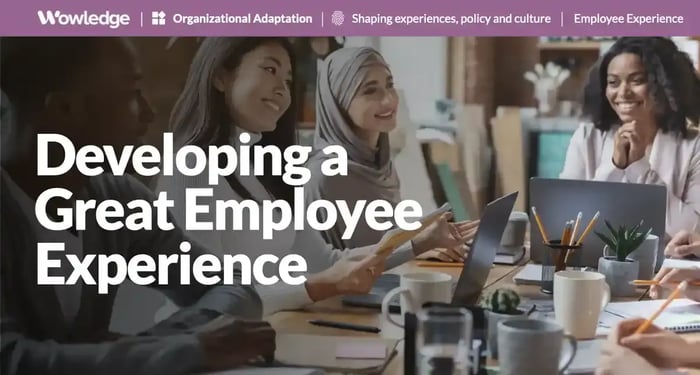Given all the challenges facing HR and leadership teams these days, those related to talent appear to be the most daunting. Even with continuing strong employment figures showing high workforce participation and low unemployment, there are still significant shortages in the available workers to fill open positions. Add to those significantly low levels of job satisfaction and employee engagement that lead to higher turnover and job hopping, especially amongst the younger and now-dominant work populations (Millennial and GenZ). As a result, organizations struggle to keep who they have while adding new staffers to their employment rolls. In such a challenging environment, those newer generations are increasingly demanding jobs and companies that bring meaning to work in addition to a paycheck.
Research has demonstrated that only 5% of workers reported that their current roles clarify their meaning to work. Furthermore, the dominant expectation of workers today is that their work should provide them with a sense of purpose. 70% of people stated that their jobs define their personal sense of purpose and that when they experience that meaningfulness and sense of purpose, they are more committed to their organization and perform better (and are 50% less likely to quit).
Providing employees with meaning to work is a key driver of their satisfaction. As we will see, many other positive outcomes exist, but too few employees experience them. While well-placed, the focus on generating high engagement and retention tends to be on equitable compensation, generous benefits, development and growth opportunities, and strong management practices. However, the greatest differentiator in achieving those ends is often upgrading each employee’s job design.
What is meaningful work?
There are many definitions of meaningful work, some more complete than others. Generally, it is best defined as a work experience that 1) aligns with an individual’s values, interests, skills, or strengths, 2) serves a higher purpose, and 3) leaves one feeling valued and fulfilled. Different experts add critical elements to this definition, including work that provides autonomy, creates a sense of competence, offers opportunities for “relatedness” or connections with others, and enhances an individual’s skills and growth.
Interestingly, what makes defining this challenging is the individualized nature of “meaningfulness.” The meaningfulness of a job is a perception of each individual job holder. Academic research compiled and summarized points to this point by defining meaningful work as “the value of a work goal or purpose, judged in relation to an individual’s own ideals or standards.” This demonstrates the need to assess meaningfulness by listening to employees in each role to understand how much their work provides them a sense of meaning and purpose as a group.
Why meaningful work is important
Providing meaning to work has proven incredibly important and highly valued by workers in research for decades. While it is getting attention now as a significant requirement and source of satisfaction for Millennial and GenZ workers, it has existed as a motivator for employees across generational boundaries. McKinsey has found that 82% of all employees consider it important that their employer has a purpose beyond revenue and profits. An article in the Harvard Business Review stated that 90% of workers would sacrifice 23% of their future lifetime earnings for a consistently meaningful job. Similarly, 70% of GenZ workers rank the company’s purpose as more important than their compensation level.
Unfortunately, most workers today feel that their jobs lack meaning and purpose. For example, 72% of surveyed employees reported that their jobs lacked the necessary amount of purpose they desired. Another study showed that only 15% of managers and employees reported fulfilling their purpose through their jobs.
While over 80% of college-educated workers actively seek meaningful career opportunities, less than 50% say they work in such jobs. This is a surprise given that degreed individuals dominate the higher-level, white-collar, exempt roles that tend to exercise greater autonomy and a closer linkage to corporate objectives and who would, therefore, be expected to have more meaningful work than their less-educated or lower-level role peers.
Another 63% of people surveyed said they wanted their employer to provide more opportunities for understanding and exercising purpose in their day-to-day work. The need to bring meaning to work for so many is extremely high and the opportunities for improvement are even bigger. But what are the potential benefits of doing so?
The value of bringing more meaning and purpose to work
Designing jobs and managing people in ways that give them more meaning has created many positive outcomes for both organizations and their employees. For example, bringing meaning to work has been demonstrated to generate significantly more motivated, committed, and satisfied employees who perform at higher levels than in companies that provide lower levels of meaning to work.
Research conducted by Gallup has shown that new graduates who are able to align their work with their strengths, interests, and values are three times (3X) more likely to experience a high level of purpose in their work and ten times (10X) more likely to report high well-being. Similarly, aligning personal purpose with that of the organization leads to higher employee engagement, loyalty to the company, and net promoter scores (NPS).
Perhaps more exciting are the outcomes of those higher levels of commitment. For example, one study demonstrated that employees with highly meaningful work spent 2.0 - 2.5% more hours per week and took two fewer days of paid leave than those without. They were also found to be 69% less likely to quit and stay for an average of 7.4 more months longer than average. Similarly, other studies have shown that employees who experience higher meaning in their jobs generate 33% better performance, 49% lower turnover, and 75% more commitment to the organization.
Scientific/academic research has also been consistent in its findings that meaningful work was positively associated with a series of positive outcomes, including significantly improved levels of:
- Employee engagement
- Work-related attitudes
- Job satisfaction
- Organizational commitment
- Intrinsic motivation
- Turnover or intention to quit
- Absenteeism
- Knowledge sharing
- Creativity
- Innovation
- Employee well-being (e.g., lowered stress, depression, and anxiety)
A related study found that employees with high levels of meaning in work exerted more effort on the job, were less likely to call in sick, more likely to take additional job-related training, and planned on delaying their retirement dates. Another demonstrated that those who perceived a larger purpose experienced greater fulfillment, scored higher on their performance appraisals, and were three times (3X) more likely to report high engagement scores.
Clearly, the most valued and sought-after talent outcomes can be achieved by bringing more meaning to work for employees across roles, functions, and generations.

Helping employees find meaning in work
Many avenues to creating more meaningful work for employees exist, and as a result, an organization-wide commitment and cultural transformation or enhancement should be embraced. Key elements to consider include organization-wide and job-specific steps demonstrated to effectively generate more meaning to work.
1. Articulate a bigger purpose
First, the organization should create a statement and aligned practices that clarify and activate its “bigger” purpose. Provide employees with insights into how the organization contributes to improving the human condition, customer lives and well-being, the environment, the communities in which it operates, etc. Vision and mission statements, as do a listing of corporate values, tend to capture these. Another good example is the environmental, social, and governance (ESG) positioning many companies have taken to meet their Board of Directors and investors' requirements. Such programs explain how the organization plans on contributing and generate regular reporting on how it is accomplishing those ends and their impact (e.g., measurables).
Communications should include how employees can find meaning in their everyday work lives. Use these five sources of meaningfulness outlined in the MIT Sloane Management Review as points of inspiration for messages to the organization:
- Organizational. The organization’s primary purpose relative to its stakeholders, including society or the environment. Provide clues as to the associated values associated with it that leaders and employees should act on.
- Job. Ways in which each role has significance for or impacts others external to the organization (e.g., customers, patients).
- Task. Understanding how significant work tasks in each role link to larger, beneficial outcomes.
- Interactional. How task outputs impact peers involved in the same workflow, and how co-worker and managerial interactions build a sense of community and mutual support.
- Holistic. The extent to which the previous four elements exist and are experienced together.
2. Create a “line of sight”
Make such organizational purpose statements relatable to the average employee. Help each one understand how their work contributes to the company’s value proposition to the world and its stakeholders. Communicate these continuously and consistently to all employees through annual statements, periodic success stories, inclusion in corporate values used in communications and performance standards, etc.
Help managers articulate how the work of the department or function is connected to that of the organization. Establish a formal process for cascading goals, such that each team is presented with top corporate objectives, and is shown how each level in their management chain has interpreted those and will contribute to their achievement. Actively engage employees in developing their own associated goals in a group setting.
McKinsey has shown that employee engagement is five times (5X) higher when the company takes the time to consider its impact on the world and that they are three times (3X) more likely to feel that their purpose at work is fulfilled when they have a chance to reflect upon how their work efforts connect to that larger impact.
3. Design jobs to be more meaningful
As previously mentioned, proactively meeting with job holders and discussing how the elements/tasks of their work are or are not meaningful is a critical starting point. Use employee listening and involvement methods such as design thinking to gather feedback and update their job duties and responsibilities to use more discretion in accomplishing tasks.
In a classic study, Hackman and Oldham found three key elements of bringing more meaning to a job where an employee can experience:
- Skill variety – use of a range of their skills and strengths
- Task identity – the ability to see their work efforts’ contributions to a complete outcome (e.g., patient wellness, project completion, product wholeness)
- Task significance – ability to understand how their work contributed to an outcome valued by the organization, community, customer, etc.
The keys to implementing this are to vary the tasks assigned to a particular job, assign work in bigger blocks to teams to allow them to jointly see a more “whole” outcome, delegate work to the lowest possible level to increase responsibility and autonomy and remind people of the connection between their work outputs and the needs of their customers.
4. Hire the right people for each job
Take the time to understand what makes a role valued and significant from the perspective of high-performing and highly engaged employees. Hire people whose personal values align with those of the job and organization to generate higher engagement, commitment, and satisfaction levels. Look beyond workers' required skills and capabilities and what makes them “tick.”
5. Understand the critical role that managers play
Leaders and managers represent a critical element of the employee experience, including how workers view the value of their work efforts, workplace, and well-being. The Brookings Institute found that the primary drivers of employees’ perceptions of meaningful work are relatedness, autonomy, and competence. Those were five times (5X) more impactful on perceptions of meaning than pay, benefits, advancement, job security, and working hours.
Furthermore, managerial behaviors that ignore employee suggestions (and are thus disempowering), are unfair (e.g., are unjust or bullying), promote bureaucracy (are contrary to the primary job purpose), or withhold recognition and acknowledgment (are depersonalizing), create a sense of worthlessness and meaninglessness. Countering those requires managers who coach, provide developmental feedback, are participative, and recognize employee contributions and achievements, as those are shown to drive improved levels of meaningfulness.
Managers also act as a conduit to communicating how employee tasks and roles contribute to the organization's and its stakeholders' larger purpose and objectives. Employees look to their direct supervisors for meaning and purpose. They should be reminded periodically (or at least when new goals or tasks are assigned) of how those contribute to the outcomes that the organization has planned or the customers will benefit from. Interestingly, only 7% of employees could fulfill their purpose at work due to a failure of their managers to help them understand what it was.
6. Make continuous development a priority
Employees who actively seek and participate in knowledge and skill development activities are better positioned to contribute and participate in decision-making. Such learning can create greater confidence in voicing opinions and ideas for improving work processes and methods while providing greater expertise that can be used to generate meaningful and impactful inputs. Learning-centric cultures positively relate to increased perceptions of meaningful work.
Relevant Practices & Tools
Developing Leaders Across Multiple Levels of Management. >
Advanced leadership development is designed to not only develop current executives, but "leaders" in all levels of the organization... more »
Designing a Communication and Engagement Strategy that Involves Employees and Establishes Trust in the Changes. >
Effective communication and engagement strategies employ Fair Process research, which shows that people care not only about an initiative’s outcomes but also about the decision-making... more »
Expanding Career Development Options to Include Hands-on and Group Learning Opportunities. >
Beyond formal learning (certifications, courses, degree programs) and standard informal methods (eLearning, mentoring), leading organizations use increasingly novel and effective... more »
Building a Culture of Coaching and Mentoring that Creates a Continuous Learning and Improvement Environment. >
Establishing and managing a sustainable culture of coaching and mentoring is an integrated effort that builds an environment where continuous development and growth take center stage... more »
The Goal Setting Template: Create Individual Goals Linked to Roles, Organizational Objectives, or Individual Development Needs. >
A template to draft SMART goals that emphasizes each element of a quality goal, including specificity, measurability, achievability, the relevance of the goal to the individual’s job... more »
About Wowledge
Wowledge is the expert-driven platform for lean teams building strategic HR programs. Members enjoy access to up-to-date best practices, step-by-step guides, tools, templates, and insights to accelerate the design and implementation of all key HR programs and processes.
Since each organization has unique characteristics, needs, and aspirations, Wowledge's practices are developed utilizing an exclusive stage-based approach – from Core to Advanced to Emerging – that reflects distinct levels of sophistication to meet our members where they are.
Build strategic HR programs with refreshingly easy-to-follow best practices.
Get started for FREE! Learn more.










